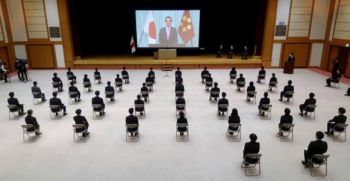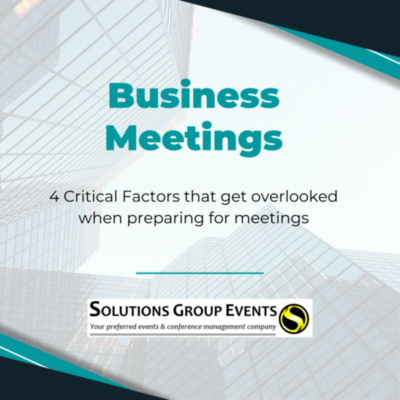
COVID CONSIDERATIONS AT CONFERENCES
For Conferences and Events scheduled to go on, the CDC has offered the following recommendations:
Considerations for Cancelling or Postponing
How many people are expected to attend? The more people an individual interacts with at a gathering and the longer those interactions are, the higher the risk of transmission.
-
- How many of the attendees are more vulnerable to Covid-19? Older adults and people with pre-existing conditions are considered to be at higher risk.
- How close will the attendees be? Person-to-person spread is most likely to occur within close contact of six feet or less.
- Are there any ways to reduce the number of attendees? Setting up socially distanced seating can help reduce the risk of transmission.
- What is the level of transmission within the local communities? Some areas have been harder hit than others. The CDC recommends consulting with the local or state public-health department.
For meetings that are scheduled to go on, the CDC has offered the following recommendations:
Before the Event
-
- Educate staff members and attendees as to when they should stay home.
- Establish flexible refund policies for anyone who falls ill, must care for a sick household member or is at high risk of contracting Covid-19 and can no longer attend the event.
- Gather supplies such as soap, hand sanitizers that contain at least 60 percent alcohol, tissues, disinfectant wipes, no-touch trash cans and face masks that will be distributed on-site. Make sure both attendees and staff members will have access to the supplies. Staff members should be required to wear face masks and attendees should be encouraged to wear them as well, especially those participants who are not vaccinated.
- Meet with the venue’s emergency operations coordinator or planning team. Discuss their emergency protocol and develop a contingency plan that addresses various coronavirus-related scenarios that could affect the meeting.
- Designate a person or office to be responsible for Covid-19 concerns. Ensure all employees and guests know who this person is and how to contact them.
- Encourage the event staff and all attendees to practice good personal health habits each day. Be sure to share resource materials from reputable sources on symptoms, prevention and more.
- Modify the event layout for social distancing. This includes limiting attendance or reducing seating capacities. Multiple entrances and exits should also be offered and event organizers should consider staggering the use of shared indoor spaces, such as dining halls and lounges.
- Prioritize outdoor activities where social distancing can be maintained.
- Offer online options in addition to in-person attendance to help reduce the number of guests on-site.
- Plan for employee absences. Event organizers should adopt flexible attendance and sick-leave policies that encourage staff members who are ill or caring for someone else who is ill to stay home. In addition, alternatives may need to be developed for those who are at high risk for contracting the virus. Staff members should be cross-trained to accommodate any changes that may arise.
- Discourage anyone who is sick from attending the meeting and request that people who begin displaying any Covid-19 symptoms leave immediately.
- Create a quarantine zone for anyone who may fall ill. Work with the local health department and hospital to create a plan for treating staff members and participants who do not live nearby and may need to be quarantined for some time. Consider drafting a plan for how vulnerable populations will be separated and cared for if need be.
- Aim to limit staff contact on-site. Develop a staggered shift schedule to reduce the risk of exposure and allow staff members to telecommute if they are not needed at the venue.
- Work with local health officials and develop a plan in case the situation changes and the meeting must be cancelled or postponed. Develop specific criteria for postponing or cancelling and outline what the refund or re-ticket policy will be. Assess whether the event could be held virtually if necessary.
- Consider limiting event attendance to guests and staff who live in the local area to reduce the risk of spreading coronavirus from areas that have high levels of transmission.
- Identify automated platforms that can be used to quickly disseminate updates to staff members and attendees via text message, email and more. Take care to consider any potential language, cultural or disability barriers that may affect communication.
During the Event
-
- Stay informed and closely follow all coronavirus-related news and updates. Pay particular attention to developments in the local area and monitor any temporary school dismissals that may affect the event staff.
- Share frequent updates with employees, participants, partners and more. Promote preventive resources and address any concerns.
- Stagger and limit attendance times to limit the number of guests in the venue at one time.
- Conduct daily temperature screenings and/or health checks of employees and guests.
- Maintain a healthy stockpile of prevention supplies such as hand sanitizer, soap and face masks. Frequently touched surfaces and objects should be cleaned on a regular basis with detergent and water prior to disinfection. Develop a schedule for increased routine cleaning and disinfection.
- Post signs in highly visible locations such as the entrances and restrooms that encourage protective measures. Broadcast regular announcements on reducing the spread of Covid-19 on public address systems and share messages on social media.
- Develop signs and messaging in alternative formats for those who are blind/have limited vision or are deaf/hard of hearing. This includes messages in large print, braille and American Sign Language.
- Limit the number of people who can use a restroom at one time and post signs or markers outside the restroom to prevent crowds from forming. Consider adding barriers between bathroom sinks.
- Avoid offering any self-serve food or drink options such as buffets and salad bars. Use disposable dishes and utensils and offer prepackaged foods or individually plated meals. Add floor markers to ensure attendees stay six feet apart while waiting in line to order or pick up food.
- Ensure ventilation systems operate properly and increase circulation of outdoor air as much as possible by opening windows and doors when feasible.
- Separate anyone who is sick from the rest of the group. Place them in a quarantine zone and give them clean, disposable face masks. Work with the local hospital and health department to provide appropriate care. Discourage infected individuals from taking public transportation, shared rides and taxis.
After the Event
-
- Hold a post-event meeting with the venue’s emergency operations coordinator or planning team to discuss lessons learned. Ask participants, partners and staff to share additional feedback.
- Look for new agencies and partners who can help improve future plans.
- Continue to monitor emergency preparedness resources and training.
Cleanliness Guidelines
Cleaning and disinfection can help reduce the risk of exposure to Covid-19 and are key to reopening public spaces, according to the CDC. The organization has issued reopening guidelines for how to properly clean public spaces, including what the appropriate disinfectants are and how frequently surfaces should be cleaned.
Content per successfulmeetings




